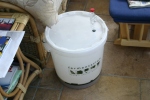- Just before our graduation
- And so it starts…
- Beginning to bear a resemblance to a certain little astromech!
- The finished article
For those of you who know me, then I am sure this post is only going to describe an event I am sure you are all aware of. However, the blog is increasingly getting views from outside of my immediate friends and family, and so I shall start at the beginning.
8 weeks ago one of my closest friends took the decision to end his own life.
I have not been totally truthful here – this is not the beginning of the story. However, poor mental health is such a taboo subject that it is often only from this point that friends or family become aware that one of their loved ones is suffering from a potentially life-threatening illness. The days of ‘The Big C’ are long since over; cancer is no longer a taboo subject which simply cannot be mentioned in polite conversation, and has to be hidden away by the sufferer. Yes, it’s frightening. Yes, it can feel defeatist, or like weakness to admit to those around you that you suffer with an illness that you cannot hope to fight without extensive treatment, and that you are afraid of the outcome. However, sufferers of this (often long-term) illness are quite rightly treated now with the respect and sympathy they deserve, rather than fear and shame.
My hope is that one day, depression and mental illness can be given the same respect. It is an illness which is not, on the whole, the fault of the sufferer. Nonetheless, the stigma associated with it dictates that the sufferer is often treated as though they can just ‘cheer up’, as though there is some blame to be apportioned to them for their suffering, or that treatment is an unnecessary luxury. Attention seeking somehow. Consider for a moment how it must feel to be afraid to die of cancer – an illness that you as an individual are powerless to stop. Now consider what that fear of death represents when you are afraid you may simply do it to yourself, and feel equally powerless. You expect nobody to take your fears seriously, and moreover, in order to receive treatment you have to beg, explaining over and over what you fear you may do to yourself. For many, this is a terrifying reality from which suicide provides the ultimate relief.
So what really happened?
The more truthful account of my friend’s life and death is this: he was a wonderful, talented, intelligent young man. Despite mental and physical illness of a severity that would have rendered a less robust person incapacitated, he achieved an outstanding 2:1 in English literature from a top university. He was a dedicated friend, a maverick, a lover of gin and a thoroughly entertaining person to be around. He had terrible taste in music, clothes and wine. He was high maintenance. He needed continuous emotional support to continue to live life as normal. He didn’t like to ‘be a burden’ to those around him, and although he was often hard work, he was an equally generous friend in return.
The last eight months saw an accelerated worsening of the depression, anxiety, and physical illness from which he had suffered for many years. His ability to go about day-to-day life was eroded a little bit at a time. Occupational health forms require that you declare mental health problems – they also ensure that you are almost unemployable. Mental health’care’ on the NHS is a total lottery depending on funding. In my friend’s case, he was sent home from hospital with a self help book when his therapist said that his suicical feelings had become out of control. Two weeks later he was found dead.
The mother of a close friend of mine is a mental health nurse, who describes a mental healthcare system almost entirely propped up by charities. These charities are having their funding systematically cut back, yet no state-sponsored health service has taken their place. Hopefully no one reading this blog will ever have to experience what my friend suffered – the humiliation of begging for help, while suffering with one of the cruellest illnesses of them all. However, the sad fact is that one in four of us will suffer from poor mental health. Even if you don’t experience it yourself, odds on someone you know will.
Why am I telling you all this you may ask.
Because something needs to be done. The hardest part about all this is that my friend isn’t coming back. We couldn’t save him. All we can hope to believe is that he is now experiencing in death the peace that he desperately wanted in life. This doesn’t solve the fact that for many out there, they are still living out the reality of mental illness without adequate support, feeling unable to express to those around them the suffering they are experiencing.
In just over a week I will be cycling 20k on my 35 year old, beaten up Raleigh shopper. I’m doing it dressed as princess Leia (I decided to auction off the right to pick my fancy dress…) and I have made a home made R2D2 to put on the back of the bike for running repairs. Mental illness isn’t always depressing. My friend would be laughing himself silly if he knew I was doing this now! I’m doing it for the charity Mind, as it helped support my friend and I through the worst of times. The most important thing they do is make mental illness talked about, and make help accessible. If you want to donate, hop on over here:
http://www.justgiving.com/Amanda-Brunton
Your support will be very much appreciated, but more importantly it’s the attitude that’s got to change. People have got to start seeing this as a real and treatable illness. People have got to stop believing that it is the fault of the sufferer. And above all, we have to start prioritising mental healthcare rather than letting vulnerable individuals fall by the wayside.
Rant over – normal cheery, food-related service will return with the next post 🙂
























